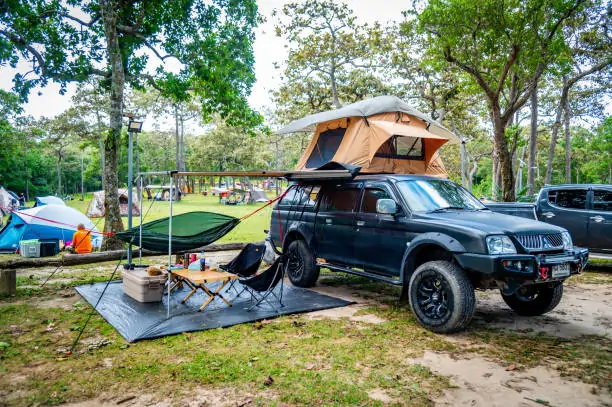Setting up camp shouldn’t feel like assembling furniture from a confusing instruction manual. An outdoor 4WD awning changes how you experience the outdoors by giving you instant shade and weather protection without the hassle of traditional tent setups. These awnings have become standard gear for off-roaders who want reliable shelter that actually works when conditions get rough. The engineering behind modern awnings focuses on quick deployment, weather resistance, and materials that can handle years of UV exposure and wind stress. Whether you’re dealing with scorching desert sun or unexpected rain, the right awning setup creates usable outdoor space in minutes.
Why Material Selection Actually Matters
Most people don’t think about awning fabric until it starts falling apart. The difference between ripstop polyester and standard canvas isn’t just marketing talk—it affects how your awning performs in real conditions. Ripstop fabrics use reinforced threading patterns that stop tears from spreading, which matters when a branch catches your awning or wind gets underneath it. UV rating is another thing manufacturers don’t always advertise clearly. A 280gsm polyester with UV50+ protection will outlast cheaper alternatives by years, not months.
The coating technology has improved a lot too. Modern PU coatings create a waterproof barrier while still allowing some breathability, which prevents that gross condensation buildup you get with fully sealed materials. I’ve seen awnings with budget coatings start peeling after one summer season, leaving sticky residue everywhere. Look for heat-sealed seams instead of stitched ones—water finds its way through needle holes eventually.
Mounting Systems and What They Mean for Setup Speed
Here’s where things get interesting. The mounting bracket is basically the foundation of your whole awning system, but people obsess over the fabric and ignore this part. Most awnings use either a track-mount or bolt-on system. Track mounts slide into existing roof rack channels, which sounds convenient until you realize they can shift during rough drives. Bolt-on systems take longer to install initially—maybe 30 minutes with basic tools—but they don’t move once they’re secured.
The deployment mechanism is where you really notice quality differences. Cheaper awnings use basic spring-loaded arms that require two people and some muscle to extend. Better systems incorporate gas struts similar to what you’d find on a car trunk. These struts do most of the work, so one person can deploy a 2.5-meter awning without struggling. Some newer designs even have quick-release pins instead of thumbscrews, cutting setup time from five minutes to under two.
Wind Rating and Actual Weather Performance
Marketing materials love throwing around wind ratings without context. An awning rated for 40km/h winds sounds solid until you’re dealing with gusty canyon winds that shift direction constantly. The rating usually assumes guy ropes are properly staked and tensioned, which almost never happens in real camping scenarios.
Aerodynamic design plays a bigger role than most specs mention. Awnings with a slight curve or angle shed wind better than flat designs. The mounting height matters too—higher mounting creates more leverage for wind to work against. I learned this the hard way when a sudden gust bent my mounting brackets because I’d installed them too high on my roof rack.
Support pole design is another overlooked detail. Telescoping poles with internal locking mechanisms are way more stable than poles that rely on external clips. The pole diameter should be at least 25mm for awnings over 2 meters. Anything smaller tends to flex too much, which stresses the connection points and eventually causes failures.
Packed Size and Storage Reality
Something nobody mentions enough—where this thing actually goes when you’re not using it. A 2.5-meter awning typically packs down to around 250cm x 18cm x 18cm, which doesn’t sound huge until you’re trying to fit it on a loaded roof rack. The mounting position affects everything else you can carry.
Some awnings come with covers, some don’t. The ones without covers get filthy and the fabric degrades faster from road grime and UV exposure during transport. Aftermarket covers exist but add to the total cost. Weight distribution on your roof rack matters more than total weight—a 20kg awning mounted off-center creates handling issues you’ll notice immediately on highway drives.
Read more: How Fire Reporting Software Enhances Incident Documentation and Analysis – Spiritual Meaning Portal
How Debt Relief Benefits from Balanced Gratification – Spiritual Meaning Portal
Elevating In-Store Visibility and Interaction Using Bar LCD Displayss – Spiritual Meaning Portal







